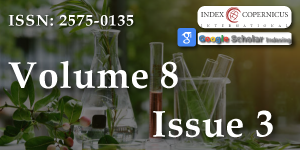Antifungal Efficacy of Panchgavya Formulations against Rhizoctonia solani: An Incitant of Rice Sheath Blight
Main Article Content
Abstract
The main rice-grown crop was found severely affected by sheath blight in the south Gujarat region. Sheath blight of rice symptoms were noticed on leaf blades and the sheath just above the water level. The isolation was done from infected parts and purified by the hyphal tip method on PDA which was maintained at 4ºC. The seven different panchgavya formulations of five cow products such as cow urine, dung, curd, ghee, and milk that designed as PG1, PG2, PG3, PG4, PG5, PG6, and PG7. The PG against test pathogen Rhizoctonia solani in vitro condition by the poisoned food technique and that tested at 2, 4, 6, 8, and 10 percent concentrations. It was observed that panchgavya were able to suppress the growth of R. solani. Among the different formulations, PG1 was significantly effective at all concentrations as compared to other PG formulations against R. solani.
Article Details
Copyright (c) 2024 Pandya JR, et al.

This work is licensed under a Creative Commons Attribution 4.0 International License.
Anonymous. Agricultural statistics at Glance, Directorate of Economics and Statistics. 2017;89. Available from: https://desagri.gov.in/wp-content/uploads/2021/04/Agricultural-Statistics-at-a-Glance-2017.pdf
Natarajan K. Panchgavya – A manual. Mapusa, Goa, India: Other India Press; 2002:33.
Sugha SK. Role of panchgavya in the management of major soil-borne fungal diseases of vegetable crops. Plant Dis Res. 2009;24(1):41-47. Available from: https://www.indianjournals.com/ijor.aspx?target=ijor:pdr&volume=24&issue=1&article=012
Amalraj EL, Kumar GP, Ahmed SMH, Abdul R, Kishore N. Microbiological analysis of panchgavya, vermicompost, and FYM and their effect on plant growth promotion of pigeon pea (Cajanus cajan L.) in India. Org Agric. 2013;3(1):23-29. Available from: https://link.springer.com/article/10.1007/s13165-013-0042-2
Dogra S. Antifungal potential of panchgavya against some soil-borne pathogens. M.Sc thesis, CSK Himachal Pradesh Krishi Vishvavidyalaya, Palampur; 2006. Available from: https://krishikosh.egranth.ac.in/items/58118466-ca51-490a-a588-4dd5d89ffe7f
Vincent JM. Distortion of fungal hyphae in presence of certain inhibitors. Nature. 1947;159:850. Available from: https://www.nature.com/articles/159850b0
Karthika SR, Sajeena A, Girija VK, John J, Heera G. Antifungal activities of organic preparations, botanicals, and non-hazardous chemicals against Rhizoctonia solani Kuhn causing sheath blight of rice. J Trop Agric. 2017;55(1):104-113. Available from: https://jtropag.kau.in/index.php/ojs2/article/view/485
Ashlesha, Paul YS. Antifungal bioefficacy of organic inputs against fungal pathogens of bell pepper. Indian J Res. 2014;3(6):1-6. Available from: https://www.worldwidejournals.com/paripex/recent_issues_pdf/2014/June/June_2014_1402919293_dfcb6_2.pdf

